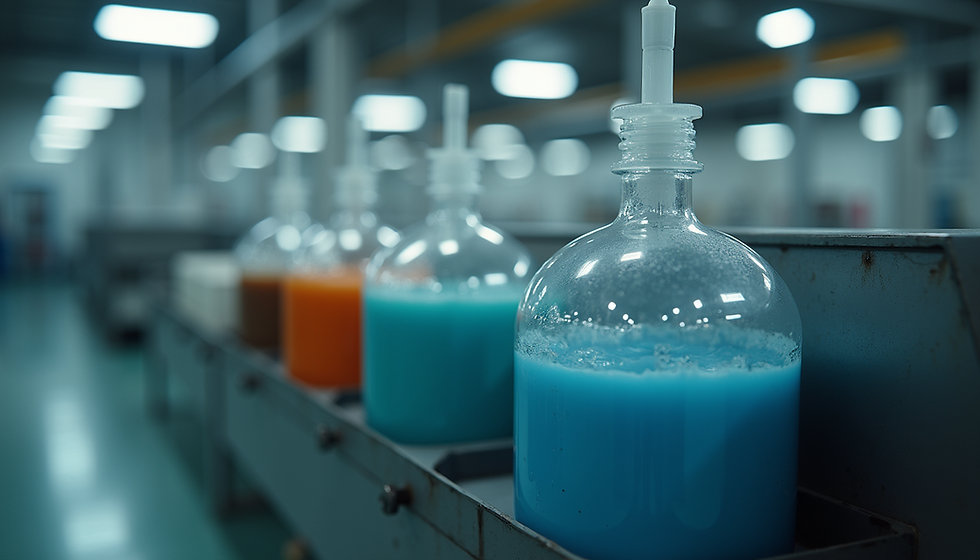Understanding the Role of Carboxylates in Modern Applications
- biofm9
- Jun 5
- 4 min read
Carboxylates have become increasingly significant in various industries, connecting science to everyday life. Understanding carboxylates, their properties, and applications can help us appreciate their role in modern technology, pharmaceuticals, ecology, and more. Let's delve into the details.
What are Carboxylates?
Carboxylates are salts or esters of carboxylic acids. They are formed when carboxylic acids lose a proton (H+) from the carboxyl group (-COOH). This transformation gives rise to a wide range of compounds that exhibit various chemical properties and functionalities. Common examples of carboxylates include sodium acetate and calcium stearate.

In nature, carboxylates play essential roles in metabolic processes, such as the citric acid cycle, where they help convert nutrients into energy. This makes them crucial in biochemistry and the life sciences.
The Chemistry of Carboxylates
Carboxylates possess unique structures that contribute to their chemical behavior. When a carboxylic acid donates a proton, the remaining carboxylate ion becomes negatively charged, which allows it to interact readily with other positively charged ions. This attribute makes carboxylates excellent in forming coordination complexes and participating in various chemical reactions.
Properties of Carboxylates
Solubility: Many carboxylates are soluble in water, an essential property for their use in various applications, ranging from pharmaceuticals to cleaning agents. For instance, sodium acetate is water-soluble and widely used as a buffering agent in biochemical experiments.
Reactivity: Carboxylates can participate in different chemical reactions, including polymerization and esterification. These reactions enable the synthesis of various materials used in everyday products.
Stability: Carboxylates exhibit stability under a range of conditions, making them reliable in storage and application. This stability lends them significant utility in food preservation and pharmaceutical formulations.

Overall, understanding these properties helps industries employ carboxylates effectively in diverse applications.
Industrial Uses of Carboxylates
Carboxylates are currently applied in several fields like pharmaceuticals, food production, textiles, and environmental science.
Pharmaceuticals
One of the major applications of carboxylates is in pharmaceuticals. Due to their excellent solubility and reactivity, they serve as intermediates in drug synthesis. For instance, acetic acid is a building block for synthesizing pain relief medications like ibuprofen. Moreover, carboxylate salts are often used as additives to enhance the absorption of medicines in the body, improving their efficacy.
Food Production
Carboxylates also find significant roles in the food industry. They are commonly used as preservatives and flavor enhancers. Sodium and potassium benzoate, for example, are carboxylates frequently employed to inhibit mold and yeast growth in acidic foods and beverages. This not only extends shelf life but also maintains the quality of food products.

Textile Industry
In the textile industry, carboxylates are vital for dye fixation and stabilization. They help improve the efficiency and vibrancy of dyes on fabrics. By using carboxylates, manufacturers can enhance the resistance of fabrics to stains and fading, which increases the durability of clothing and other textile products.
Environmental Applications
Carboxylates are also harnessed for environmental applications, particularly in wastewater treatment and soil remediation. They can help chelate heavy metals, making them easier to remove from contaminated soil or water. Moreover, carboxylates can act as surfactants, reducing surface tension and improving the dispersion of contaminants during remediation processes.
The Future of Carboxylates
With ongoing research and innovation, the future of carboxylates seems promising. Scientists are exploring the potential of these compounds in renewable energy technologies, such as in the synthesis of biofuels. Carboxylate chemicals, for instance, have shown potential in creating sustainable energy sources from organic waste materials.
Moreover, advancements in nanotechnology are paving new ways to utilize carboxylates in drug delivery systems, improving targeted treatment methods in healthcare.
Practical Recommendations for Using Carboxylates
Research and Development: Businesses looking to utilize carboxylates in their products should invest in research and development. For example, if you're in the food industry, explore how carboxylate preservatives can integrate with your current formulations to maximize preservation while ensuring food safety.
Environmental Awareness: If you're involved with environmental initiatives, consider how carboxylates can aid in soil and water remediation projects. Incorporating carboxylates into treatment processes may enhance efficiency and effectiveness.
Staying Informed: Keep abreast of the latest research and findings in carboxylate applications across various industries. Attending workshops and conferences can provide valuable insights and networking opportunities.
Testing and Quality Control: Businesses should prioritize quality control when formulating products containing carboxylates. Regular testing can ensure that they maintain the desired properties and efficacy in their applications.

By understanding the diverse applications and benefits of carboxylates, individuals and companies can harness their potential to improve processes, products, and environmental strategies.
The Benefits of Carboxylates in Industry
Carboxylates have specific benefits that have cemented their role in various industries. For example:
Cost-effective: Carboxylates can often be produced at lower costs compared to alternative compounds, making them an economical choice for manufacturers.
Versatile: Their wide range of chemical properties allows carboxylates to be used in multiple applications, making them indispensable across industries.
Eco-friendly Options: Some carboxylates are derived from renewable resources, providing environmentally sustainable alternatives to synthetic chemicals.
Ultimately, the versatility and efficacy of carboxylates make them paramount in modern applications. Their ongoing relevance in scientific research, industry development, and environmental protection will likely increase, paving the way for innovative solutions across various fields. As technology continues to advance, further understanding and application of carboxylates will enhance our capabilities in science and industry alike.







Comments